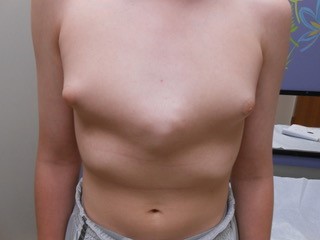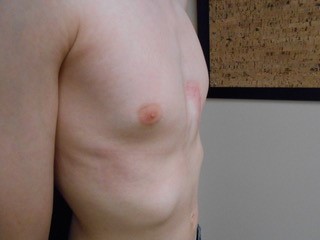Chest wall center in Denver
The pediatric surgeons within the Rocky Mountain Pediatric Specialists network skillfully treat chest wall abnormalities like pectus carinatum (pigeon chest) and pectus excavatum (sunken chest) in children of all ages. While the condition can occur in both sexes, it is about four times more likely to occur in boys than in girls.
The Chest Wall Deformity Correction Center at Rocky Mountain Hospital for Children is one of only six chest wall repair clinics in the U.S. — and the only facility in the western part of the country — offering the dynamic compression device brace to treat pectus carinatum. Our physicians and staff are dedicated to your child’s health and are constantly at the forefront of research and innovation.
For more information about our Chest Wall Deformity Correction Center or to schedule an appointment, call us at (303) 839-6001.
Pectus carinatum

Pectus carinatum is a common pediatric condition identified by an overgrowth of rib cartilage that causes the chest to protrude forward. The most common manifestations of pectus carinatum occur:
- In pre-adolescent males between 11-14 years old during a growth spurt
- From birth, identified around 2-3 years old
- After open-heart surgery (least common)
Pectus carinatum symptoms
Most people with pectus carinatum will develop normal hearts and lungs, but the deformity of the chest wall may prevent them from functioning at optimal capability. Many people with pectus carinatum, especially children, will experience:
- Shortness of breath during activity
- Decreased endurance
- Occasional chest pain
In addition to physical symptoms, there can also be psychosocial implications. The shape of the chest can cause embarrassment, lack of self-confidence and possible disruption to social connection through adolescence and into adulthood.
Pectus carinatum treatment

Before bracing

After bracing
Pectus carinatum can be treated in two ways.
- The dynamic compression device brace is the first treatment choice during childhood and adolescence due to its minimally invasive, overall positive results. Because the chest is still growing during childhood and adolescence, the brace applies just enough pressure to correct the abnormality but encourages gradual movement to the sternum so that it is still comfortable for the child to wear.
- Surgical correction for PC is a well-established and recognized option for treatment when the bracing is not appropriate or fails to correct the deformity. Surgeons repair the abnormality by reshaping or removing abnormal rib cartilage. Sometimes, they may make additional changes to the sternum or reposition it.
Pectus excavatum
Pectus excavatum is the most common chest-wall abnormality. It is caused by an abnormal growth of cartilage where the ribs connect to the sternum, causing the breastbone to sink inward. It is most noticeable during the early teenage years during a rapid growth spurt.
The most common symptoms of pectus excavatum include:
- Back pain
- Shortness of breath
- Exercise intolerance
- Chest pain
A diagnosis requires a physical examination with a pediatric surgeon.
Pectus excavatum treatment
The Nuss procedure is a minimally invasive type of surgery that places a curved steel bar under the sternum. The bar is customized to each patient and instantly corrects the PE. The bar is not visible from the outside and stays in place for at least two years.
Patient success story
Meet our patient Kai, a Hawaiian teen who traveled to Denver for chest surgery to correct his pectus excavatum.
Pectus excavatum and pectus carinatum locations
